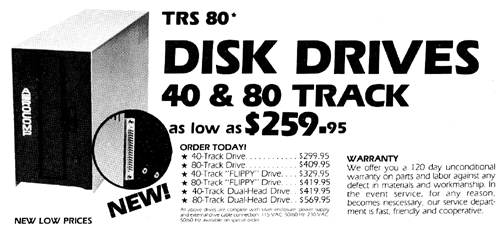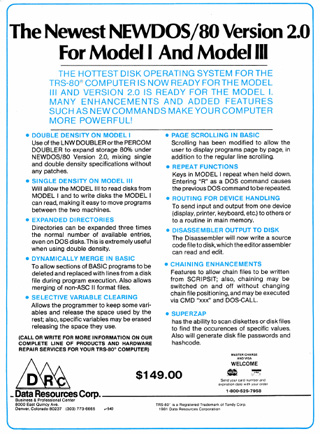NewDos/80, version 2.0 and the JV1 Disk Image format
(Note: If you arrived here via a seach engine, you might want to check out the parent page which is the Disk Archive section)
Introduction
This page is for those who want to explore, or understand a little more, about the jv1 .DSK disk image format used, and why I selected it for the disk images on this site. I'll also give some background to NewDos/80 version 2, as this DOS partly-determined why I used that particular format.
I'll point out from the onset that this section is not for TRS-80 stalwarts, who will know all of this material and in much greater detail and depth than me! It's more for those new to the TRS-80 world who wish to dig a little deeper into the historical and technical aspects of using virtual TRS-80 disks.
1978 - 1981. System Smorgasbords
The period covering the late seventies and early eighties was wonderful time to be interested in micro computing. New machines were appearing by the month, each one different from the other. Not only did they look different, but they were mostly incompatible with each other as far as software was concerned. This was frustrating for owners, who often purchased machines that were devoid of software, but it was also a very innovative time. Every computer manufacturer was trying to make their mark with this new technology. There were no corporate software giants. Software writers were largely small companies or individuals providing product for the limited number of microcomputer users at the time.
Nowadays we live in a world where (at the time of writing - 2007) only three operating systems hold sway. By far the largest is Microsoft's Windows line, followed by Apple's Mac-OX and then open-source Linux. Back then though, there were dozens of DOSes, often tailored to a particular machine. Even a purchaser of a particular make and model could choose between half a dozen products when it came to the DOS.
Such was the case with the TRS-80 Model 1 and it's clones, such as the System 80/Video Genie/PMC-80. When the disk version of the TRS-80 model 1 was first released, it came with a DOS called TRS-DOS. Back then, the choice of disk drive hardware was very limited. All you could get was a 35-track, single-sided drive. However, within a couple of years, all sorts of options were becoming available. A piece of hardware (a doubler) could be purchased that doubled the capacity of a disk, by writing more data to it. This was called double-density. Also, disk drives were appearing that could write up to 80 tracks on the disk...and on both sides rather that just one! A 5.25-inch floppy disk went from holding 85 kilobytes of data (35 track, single-density, single-sided) to being able to cram in 733k when used with hardware that supported 80 tracks, double-density and double-sided.

A proliferation of DOSes
The Model 1 version of TRSDOS never really kept pace with these developments. TRSDOS was limited and a little buggy. It was also owned by Tandy who were more interested in selling machines than software. Consequently keen users (including Randy Cook, who Tandy had contracted to write the original TRSDOS) soon started to write their own. Some were good enough to sell and within months the '80s user had a number they could select from. These included DosPlus, NewDos, MultiDos, VTOS and LDOS; all competitors in a small but growing market.
TRS-80 DOS writers faced a big challenge. How could an operating system be written that took into account all the possible configurations a user might have? For example, a TRS-80 or clone user might have a system with four drives. One drive might be single-sided and 40 track, while another might be 80 track and double-sided. The two remaining drives might be 80 track and single-sided. Furthermore, our user might have single density, but they most likely want to be able to exchange data disks with someone who had a double density system?
NewDos/80 version 2.0
 Each
DOS provided support for multi-configurations to a lesser or greater extent,
but no one Model 1 DOS seemed to do it quite as well as NewDos. By it's
final version, NewDos/80 version 2.0, users could virtually have their
own personal disk format if they wanted to. Using it's powerful PDRIVE
command, the boot disk could be configured to read, write and format disks
in a myriad of ways, to take maximum advantage of the hardware.
Each
DOS provided support for multi-configurations to a lesser or greater extent,
but no one Model 1 DOS seemed to do it quite as well as NewDos. By it's
final version, NewDos/80 version 2.0, users could virtually have their
own personal disk format if they wanted to. Using it's powerful PDRIVE
command, the boot disk could be configured to read, write and format disks
in a myriad of ways, to take maximum advantage of the hardware.
Most System 80s were initially purchased without disk drives. Later, drives would be added bit by bit as finances allowed, so it wasn't uncommon to see a number of drives types attached to one machine. It's ability to handle this kind of scenario made it a very popular DOS, especially with System 80 users in Australia and New Zealand.
This wasn't the only reason NewDos/80 v2 was loved though. It was also a "geek's" DOS. By that I mean you could fiddle with it, and tweak it, change it and personalise it. The switches and options seemed endless. It was a challenge and it was a lot of fun! Once you had "mastered" NewDos/80 v 2.0, you really felt you had come of age in mico-computing terms. After cutting your teeth on NewDos, MS-DOS (popular on PCs) was a walk in the park!
Compatibility
Despite there being a lot of different DOSes around, a kind of disk format standard did exist to ensure backward compatibility. This was set by the original TRSDOS. Although you could customise your own DOS as much as you like, if you wanted to share disks with others, it was safer (although limiting) to format them to conform to the TRSDOS standard. For example, the directory track in TRSDOS was track 17. You could easily change this in NewDos to another track, but if you gave your "customised" disks to someone else, they would not have been able to read them unless they had NewDos AND you had told them where you'd put the directory. If you were going to format a disk you were going to share, or distribute, you would probably also make it single-density, single-sided and 40 track, even though storage space would be limited. People with double-sided drives of 80 tracks and with double-density, could read these disks, but not vice-versa. Hence the single-sided, 40 track, single-density disk with TRSDOS sector and mapping parameters became the "lowest common denominator" of the TRS-80 world.
Emulators and the jv1 format
 Around
the early 1990's people started to work on TRS-80 model 1 emulators. One
of the first to do this for MS-DOS was Jeff Vavasour. Jeff wanted to emulate
a disk-based system. He needed to decide therefore, how to represent these
disks in virtual format. He choose a simple representation, which assumed
our "virtual system" was single-density, single-sided and no
more than 80 tracks. Double-sided operations and double-density was not
supported.
Around
the early 1990's people started to work on TRS-80 model 1 emulators. One
of the first to do this for MS-DOS was Jeff Vavasour. Jeff wanted to emulate
a disk-based system. He needed to decide therefore, how to represent these
disks in virtual format. He choose a simple representation, which assumed
our "virtual system" was single-density, single-sided and no
more than 80 tracks. Double-sided operations and double-density was not
supported.
This format for TRS-80 Model 1 disk images became know as the jv1 format, after Jeff's initials. He later developed another format for a TRS-80 Model III/IV emulator which supported double density. David Keil also developed a format, DMK, which mirrored the hardware possibilities more closely. More information on these formats can be found under Tim Mann's link below.
Why I chose the jv1 format for the virtual disk archive
My emulator of choice is Matthew Reed's TRS32. This is an excellent emulator, which can use jv1, jv3, and DMK virtual disks (.DSK) of any density or side, and/or track number. The emulator can also create jv1, jv3 or DMK DSK files (depending on which extension you give the file on creation), which can then be formatted from within the emulator.
Despite the fact that DMK and jv3 could hold more data, I chose the jv1 format for the archive disks, for the following reasons...
- Jv1, being an older and relatively simple format, is accommodated by most TRS-80 Model 1 emulators including Attila Grosz' HT-1080 system-80/video genie emulator. Like the original TRSDOS format was with the real computers, jv1 is the "lowest common denominator" amongst TRS-80 Model 1 emulators.
- Jeff Vavasour had written some free MS-DOS utilities which could read and write files from jv1 .DSK files into the MS-DOS environment. Hence this was a way files could be transferred between the PC and Virtual TRS-80 world. This reason is now somewhat redundant as Matthew Reed has since released the excellent TRSTOOLS, an MS Windows program which can do the same thing, except easier.
- TRS32 DMK .Dsk files were either 500Kb for 40 track drives or 1000kb for 80 track drives regardless of density or single/double sidedness. The largest jv1 .dsk disks (single density, single-sided and 80 track) take up only 200k.
Further Reading
- Common File Formats for Emulated TRS-80 Floppy Disks, by Tim Mann